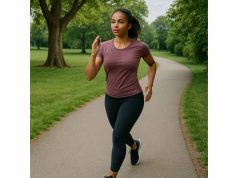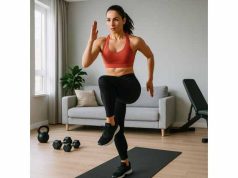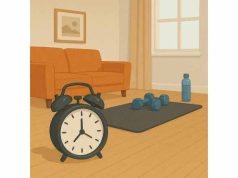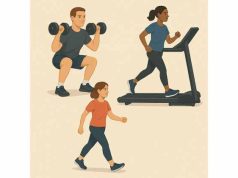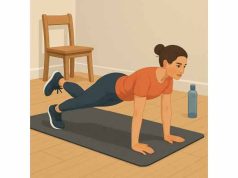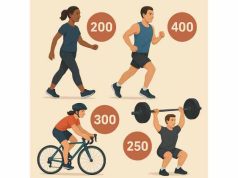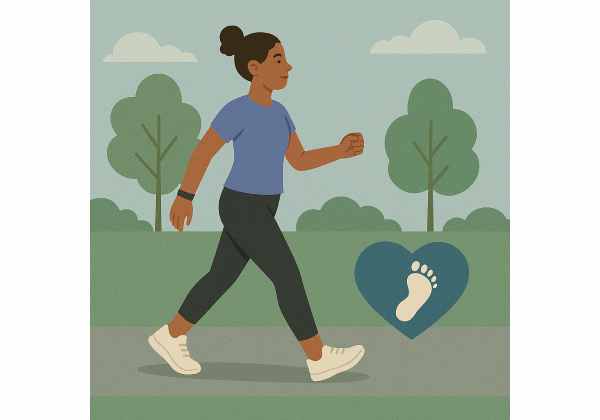
Walking is the most underrated fat-loss tool: free, joint-friendly, and easy to scale. You can slot short walks into busy days, extend a weekend route, or add light hills to raise the challenge without injury risk. This guide clarifies how many steps actually move the needle, how pace and terrain change the burn, and how to build weekly plans that you will repeat. You will also learn how to track reliably, troubleshoot plateaus, and protect your feet and joints. For the bigger picture on blending steps with strength and cardio, see our training components for fat loss guide.
Table of Contents
- Why steps drive fat loss
- How many steps per day?
- Pace, time and intensity
- Weekly plans by level
- Tracking: devices and accuracy
- Stalling? Adjust calories and activity
- Technique, safety and foot care
- Frequently Asked Questions
Why steps drive fat loss
Walking is “quiet” calorie burn. Unlike a hard workout that leaves you breathless, steps raise daily energy expenditure in the background all day long. This non-exercise activity (NEAT) includes your commute, errands, and movement breaks. NEAT varies hugely between people and often explains why two people eating similarly lose weight at different rates. When you increase steps consistently, you raise NEAT without the recovery costs of high-intensity sessions.
Why this matters during weight loss:
- Consistency beats spikes. You can walk most days, even when life is stressful. A predictable habit produces predictable results.
- Low orthopedic cost. Walking spreads load across the hips, knees, and ankles with low impact, letting you accumulate weekly minutes with less soreness.
- Appetite and sleep synergy. Gentle activity often improves sleep quality and helps appetite cues stay steady—underrated levers for fat loss.
- Metabolic flexibility. Regular walks improve how you handle carbs and fats, making a small calorie deficit feel easier to maintain.
“More is better” only up to what you can repeat. The sweet spot is a sustainable step target that keeps you moving without crowding out strength training or recovery. Strength protects muscle while the scale moves, and short cardio sessions can complement steps—but steps are the volume base.
A practical way to start is to baseline your average week for 5–7 days without changing anything. Most adults fall between 3,000 and 8,000 steps. Then set a new target 1,500–2,000 steps above your baseline, and hold it for two weeks. If you recover well and your schedule allows, climb another 1,000–2,000 steps. This staged approach builds tolerance in your feet, calves, and hips.
Use terrain as an intensity knob. Modest hills or a treadmill incline (2–4%) recruit the posterior chain without turning your walk into a grind. If you already lift, space longer or hillier walks away from heavy lower-body days.
Finally, remember that the goal is total weekly minutes at an effort you can repeat. An extra 10–15 minutes after lunch and dinner adds 20–30 minutes daily—without disrupting your calendar. Those minutes add up to thousands of extra steps weekly.
For a quick refresher on safe rate of change and habit building, scan our safe weight-loss basics and then use the targets and plans below.
How many steps per day?
There is no single magic number, but ranges are useful. What you need depends on your baseline, body size, pace, and diet. Use the tiers below as targets you can maintain, not temporary challenges.
Starting from sedentary (≤3,000/day):
- Goal 1: 5,000/day average for two weeks.
- Goal 2: 6,500–7,500/day once your feet and calves adapt.
- Why it works: Jumping straight to 10,000 can cause blisters or shin soreness. Progress by 1,500–2,000 steps/day every 10–14 days.
Typical lifestyle (4,000–7,000/day):
- Fat-loss range: 7,500–10,000/day for many adults.
- Why it works: This range meaningfully raises daily expenditure without excessive time demands. Combine with two short strength sessions weekly for muscle retention.
Highly active or faster loss (10,000–14,000/day):
- Useful when you have time, tolerate volume well, and want a larger energy gap without slashing calories.
- Monitor feet, shins, and sleep. If recovery dips, reduce volume for a week.
Time translation (estimates):
- 2,000 steps ≈ 1 mile (1.6 km) for many adults.
- Brisk pace: ~100–120 steps/min.
- 7,500 steps ≈ 60–75 minutes of purposeful walking spread across a day.
- 10,000 steps ≈ 80–100 minutes depending on stride.
Choosing your number:
- Baseline your current average for a week.
- Add 1,500–2,000 steps/day and hold it for two weeks.
- If weight loss stalls and recovery is good, raise by 1,000–2,000 more.
You do not need to hit 10,000 exactly. Some weeks you’ll average 8,400; other weeks 9,700. What matters is the trend.
If you want a deeper dive on the popular 10k figure—what it means for pace and realistic expectations—see our focused guide to 10,000 steps for weight loss.
Pace, time and intensity
Steps measure volume; pace controls intensity. You can shift calorie burn and training effect by walking a bit faster, choosing hills, or extending one longer session each week.
Pace anchors (use RPE and talk test):
- Easy (RPE 3–4): You can speak in full sentences; good for most minutes.
- Brisk (RPE 5–6): Short sentences; breathing elevated but controlled.
- Hard segments (RPE 7–8): You can say only a few words; use sparingly.
How to get more from the same minutes
- Brisk finish: Walk easy for 20 minutes, then 5–10 minutes at a brisk pace.
- Micro-hills: Insert 4–6 short hills (60–90 seconds up, easy down).
- Walk “commutes”: Park farther and walk the last 5–10 minutes to and from destinations.
- Treadmill incline: 2–4% for longer blocks; 5–8% for 60–90-second bursts at an otherwise comfortable speed.
Interval templates (20–30 minutes total)
- 2:1 rhythm: 2 minutes brisk, 1 minute easy × 8–10.
- Hill pops: 60 seconds at 5–8% incline, 60 seconds at 1–2% × 8–12 (speed comfortable).
- Pyramid: 1–2–3–2–1 minutes brisk with equal easy walking between.
Cadence matters
Shorten stride slightly and increase cadence to around 110–120 steps/min for brisk segments. Overstriding increases braking forces and can irritate shins and knees.
Energy management
- Spacing brisk work on non-lifting days protects recovery.
- If appetite spikes after longer walks, anchor meals with protein, fiber-rich carbs, and produce; avoid “grazing back” the entire deficit.
Prefer simple heart-rate guidance? Use the same conversational Zone-2 ideas you would for cycling or jogging—steady, repeatable effort with occasional controlled surges. Our overview of Zone 2 cardio explains the framework and how to test your easy range.
Weekly plans by level
These templates translate targets into schedules. Swap days to fit your life. The intent is repeatable volume, not perfection.
Sedentary → Starter (Weeks 1–4)
- Daily: Split 20–30 minutes into two or three 8–12-minute walks (after meals if possible).
- Weekly goal: 5,000–6,500 steps average.
- Optional: One “brisk finish” day (last 5 minutes faster).
- Guardrails: If shins or feet ache, insert a lighter day (3,500–4,500 steps).
Builder (Weeks 5–8)
- Mon: 25–35 minutes easy (flat or 1–2% treadmill).
- Wed: 20–30 minutes with 2:1 rhythm (brisk\:easy).
- Fri: 30–40 minutes steady; last 10 minutes brisk.
- Weekend: Optional 20–30 minutes family walk.
- Weekly goal: 7,500–9,000 steps average.
Strong base (Ongoing)
- 3 structured walks (30–45 minutes; one with hills) + daily micro-walks (5–10 minutes after meals).
- Weekly goal: 9,000–12,000 steps, scaled to schedule and recovery.
- If you also lift: Place the longest walk 24–48 hours away from heavy lower-body training.
Prefer indoor sessions? Our treadmill incline and interval guide gives plug-and-play workouts that pair with these weekly targets.
Tracking: devices and accuracy
The best tracker is the one you will wear. Accuracy differences exist, but consistency of method matters more than small device errors.
Phones vs. wearables
- Phones undercount if you leave them on a desk, push a stroller, or carry them in a backpack.
- Wrist devices can overcount during chores that mimic arm swing; most modern models filter better than older ones.
- Hip clip-ons track steps accurately but are easy to forget.
Practical accuracy tips
- Stick with one device day to day.
- Wear it in the same position (same wrist; same pocket).
- Use a 7-day rolling average to smooth noise from busy and light days.
- If you push a stroller or grocery cart, mount the device on your wrist that swings freely or consider a hip clip during those walks.
What to log beyond steps
- Minutes and routes. They show effort when steps are similar.
- RPE notes. A one-line note (“brisk hills felt easy”) helps track progress.
- Footwear age. Replace walking shoes every 500–800 km (300–500 miles) or when cushioning feels flat.
Desk jobs and “movement snacks”
Sitting long stretches shrinks NEAT. Use micro-bouts—3–5 minutes every hour—to add 1,000–2,000 steps without a formal workout. For structured ways to move during office hours, see our movement plan for desk jobs.
Stalling? Adjust calories and activity
Plateaus are normal. Metabolism adapts, and daily movement sometimes drifts down as you add “formal” walks. Troubleshoot with small, trackable changes.
Checklist (in order):
- Audit steps. Has your true daily average slipped? Re-establish your target.
- Add 1,000–2,000 steps/day for 10–14 days if recovery is good.
- Preserve muscle. Keep two short strength sessions weekly; muscle retention keeps resting burn and shaping.
- Tighten meals slightly. Trim 200–300 kcal/day by swapping calorie-dense extras (oils, sugary drinks) for lean protein and produce.
- Prioritize sleep. Poor sleep increases hunger and lowers activity the next day.
Signals to reduce, not increase
- Persistent foot or shin pain; shoes past their lifespan; sleep below 6 hours; irritability during usual walks. Take a lighter week (reduce volume ~20–30%).
Blending with workouts
- If you also cycle, swim, or lift, keep most walking easy. One harder walking session weekly (hills or brisk intervals) is plenty.
- As time tightens, protect your steps with two meal-time walks (10–15 minutes) and one longer weekend session.
For a refresher on which exercises deliver the best return during weight loss, read our concise overview of effective strength and cardio choices.
Technique, safety and foot care
Good walking mechanics are simple and protect your joints as volume rises.
Form cues
- Posture: Stand tall; ribs stacked over pelvis; eyes forward.
- Foot strike: Land under your body; roll through the foot; avoid overstriding.
- Cadence: Slightly quicker steps for brisk segments; shorter stride on hills.
- Arms: Elbows bent ~90°; hands relaxed; natural swing.
Terrain and incline
- Start flat or with gentle hills. Reserve steep grades for short segments to protect calves and Achilles.
- On treadmills, avoid leaning on rails; if balance is an issue, reduce incline or speed.
Footwear
- Choose comfortable daily trainers with secure midfoot hold and room in the toe box.
- Replace when the midsole feels packed out or you see uneven outsole wear.
Blister prevention
- Moisture-wicking socks; consider a thin liner.
- Lubricate hotspots (heels, toes) before long walks.
- Lace for foot shape—heel-lock lacing can reduce slipping.
Hot and cold weather
- Heat elevates heart rate; slow pace slightly and hydrate.
- In cold, warm up longer; choose grippy soles for snow or rain; wear reflective gear after dark.
When to seek professional guidance
- Sharp or worsening pain, swelling, or night pain; recurrent numbness or tingling; new balance issues. A clinician can assess gait and rule out stress injuries.
Frequently Asked Questions
Is 10,000 steps necessary to lose weight?
No. Many adults lose weight at 7,500–10,000 steps/day with a modest calorie deficit and two short strength sessions. Ten thousand is a simple, memorable benchmark, but the right target is the highest average you can sustain without aches or schedule chaos.
How many steps equal a pound of fat?
Very roughly, 35,000–40,000 steps at typical paces may match a 3,500-kcal deficit, but this varies by body size and terrain. Treat steps as a consistency tool, not a precise calorie budget. Combine them with small nutrition changes for reliable, sustainable loss.
Are several short walks as effective as one long walk?
Yes. Splitting 30–45 minutes into two or three 10–15-minute walks often improves adherence, lowers soreness, and steadies appetite. Total daily minutes and weekly steps matter more than whether they occur in one continuous session.
Should I prioritize pace or step count?
Start with a step target to anchor volume, then layer in brief brisk segments (RPE 5–6) to improve fitness. As you adapt, keep most minutes easy and use 1–2 faster blocks weekly for variety and a small metabolic bump.
Do I need to count calories if I track steps?
Not always. Many people succeed by setting a step target and using structured, repeatable meals that keep portions consistent. If progress stalls, a short period of calorie logging can reveal hidden extras and help you adjust by 200–300 kcal/day.
Why does my tracker show fewer steps when I push a stroller?
Wrist trackers count arm swings. Pushing a stroller reduces swing, so steps under-register. Wear the device on the free arm, clip a pedometer at the hip, or accept the undercount and track time walked for those sessions.
How fast should my brisk walk be?
A brisk walk is the pace where you can speak in short sentences (RPE 5–6). For many adults, that is roughly 100–120 steps/min or 15–18 minutes per mile (9–11 min/km). Use feel first, then numbers as guardrails.
References
- Daily steps and all-cause mortality: a meta-analysis of 15 international cohorts 2022 (Systematic Review & Meta-analysis)
- The association between daily step count and all-cause and cardiovascular mortality: a meta-analysis 2023 (Systematic Review & Meta-analysis)
- World Health Organization 2020 guidelines on physical activity and sedentary behaviour 2020 (Guideline)
- Cadence as a Behavioral Target in Physical Activity Interventions: A Narrative Review 2024 (Review)
- Accuracy and Acceptability of Wrist-Wearable Activity-Tracking Devices: Systematic Review of the Literature 2022 (Systematic Review)
Disclaimer
This article is educational and not a substitute for personalized medical advice. Consult a qualified health professional before changing your exercise or nutrition plan—especially if you have cardiovascular, metabolic, or orthopedic conditions, are pregnant, or are returning from injury or surgery.
If this guide helped you, consider sharing it with a friend. You are welcome to follow us on Facebook or X for steady, practical templates and evidence-informed updates.

